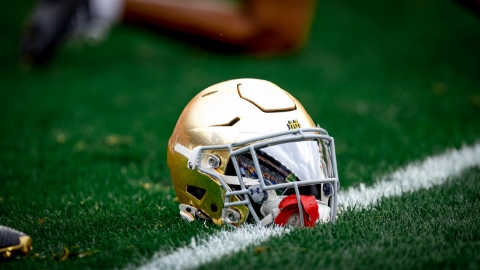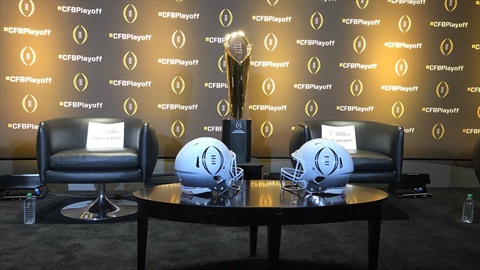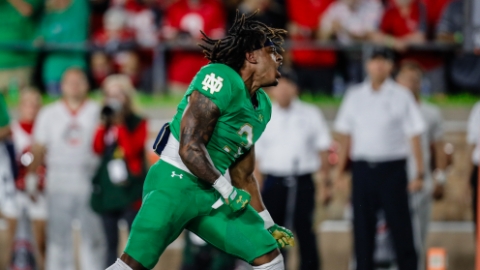
Despite some programs going full throttle in the transfer portal, compiling a high percentage of top recruits from high school is still the best path to winning a championship.
It was proven again last year when Michigan became the thirteenth straight national champion to have a Blue-Chip Ratio over 50%. BCR is the percentage of blue-chips (4 and 5-star recruits) who have signed with a program over four years. It was created by Bud Elliott, who was at SB Nation and has now moved on to 247Sports.
Every year he lists the programs who have a BCR of over 50% and every year the champion comes from that list. He put up the 2024 list on Tuesday and it features 16 teams.
Notre Dame is there with a 67% BCR from 2021-2024. I’ll get back to the Irish in a moment, but first, let’s address the eight teams at the top.
Ohio State 90% (!)
Alabama 88%
Georgia 80%
Texas A&M 79% (I’ll add more context to this)
Oregon 76%
Oklahoma 73%
Texas 72%
LSU 70%
No one should be surprised to see the three at the top and if you’ve followed along with things I’ve written about A&M, it’s not a surprise either. Oregon being up there might come as a shock to some, but there’s a reason why Dan Lanning never considered leaving when big jobs were opening up. They’ve made a massive investment in every area of the program and they now have the right coach who is taking full advantage of that investment.
Everyone else is a traditional blue-blood program and it’s almost an expectation to see them where they are.
The reason why I wanted to highlight the top-eight is to point out how much has changed in the last decade. In 2015, there were only 12 teams who cracked the list. The top team was Alabama at 77%. The second team was USC at 70%.
In nine years it’s gone from two to eight programs at 70% or more. There were only six teams 60% or higher in 2015. It’s more than doubled to 13 for this upcoming season. The gap between the top teams in the country and everyone else is getting wider.
Notre Dame is ninth this year at 67%. That’s a significant number for a few reasons. We can start with it being tied with the highest BCR they’ve had, which was also in 2015.
This brings us to the ever-present question, “Have they closed the gap?” That’s always been the wrong question because the real gap is between these 16 teams and everyone else. The distance between them and most others chasing them has only widened.
Fortunately, Notre Dame is included with “them”. Unfortunately, 67% would have been the fourth highest BCR in 2015 and it’s not now. However, getting back up to 67% is more evidence that Marcus Freeman has improved recruiting.
The year before he was hired as defensive coordinator, the BCR for Notre Dame was 55%. Signing 12% more blue-chip recruits is great. What’s even better is that they’re going to be over 70% for the first time for the 2025 season.
Right now it’s at 73% with the current commits in the 2025 class and all of the remaining targets in the ‘25 class are blue-chips and could get to 74%. I’d say an 18-19% increase is pretty, pretty, pretty good.
As Elliot pointed out in his article, BCR is not a requirement to make the College Football Playoff, a useful tool to pick individual games, nor is it a substitute for player development, culture, or coaching.
But the entire point of BCR is that no one can win it all without compiling a significant amount of raw talent through recruiting. Notre Dame is doing that better now than they ever have before and significantly better than when Brian Kelly left for LSU.
2. Transfers are too prevalent today for them not to matter at all, but I haven’t seen anything that correctly calculates roster retention. It’s significantly easier to track recruiting rather than tracking all the players who transfer out, medically retire, or simply choose to move on from football.
Elliott calculated what BCR looks like when including transfers who have signed with programs, which is a little bit easier to get a hold of. Just about every program’s BCR ticks down based on those ratings.
Notre Dame goes from 67% to 63%, which is normal. Texas A&M goes all the way from 79% to 63%. That’s by far the most significant drop. The second closest is Oklahoma, who is down 10% when transfers are included.
A&M is still very talented. They just aren’t close to that Ohio State/Alabama/Georgia level.
15 of the 16 teams who are on the original BCR list are still over 50% with transfers added. The only team who was swapped in was Florida State for Auburn at the bottom of the list.
If we take the strictly recruiting list, the Irish only play two of the 16: A&M and USC (59%). It’s three on the list that includes transfers: A&M, USC (54%), and FSU (53%).
I know Notre Dame’s schedule isn’t being lauded for how difficult it is, but let’s not pretend it’s not without challenges. They also were supposed to have Miami visiting South Bend before the Hurricanes were able to back out of the game. That would be one more team over the BCR threshold (61%).
This isn’t close to the toughest schedule Notre Dame has played in recent years, but anyone who tells you that they have it easy is probably also yelling at them to join a conference for no particular reason. They’re facing three teams who recruit at a very high level and it would have been four.
3. The Athletic’s Bruce Feldman recently made some pre-season CFP picks and Notre Dame was included. Miami was as well...which, okay? Sure, why not?
It’s undeniable that Miami has a lot of talent on their roster. They’ve recruited better under Mario Cristobal and their NIL operation has helped them land big fish in the transfer portal as well. There’s that and the fact that they have an easier path than most.Florida and FSU are the only two BCR teams they have on their schedule now that they don’t have to play Notre Dame.
Out of the 16 BCR teams, it's Clemson (Georgia and FSU), Penn State (USC and Ohio State), Oregon (Ohio State and Michigan), and Miami as the only programs who face less than three.
Florida plays six(!). Georgia, Texas, and Texas A&M play five each (welcome back, Mike Elko!). Ohio State, Michigan, Alabama, Oklahoma, USC, LSU, and FSU, all play four. Some of these SEC teams are playing Missouri and Ole Miss as well, who I wouldn’t classify as national championship contenders, but could make the CFP.
It’s difficult for a team to go undefeated in any regular season. Miami, Clemson, Penn State, and Oregon should have a better chance of accomplishing it because of their schedules. Notre Dame definitely has a greater opportunity to go 12-0 than Georgia and Texas simply because the Irish play less games against teams with elite recruiting.
4. As Elliot pointed out, 13 of the 16 teams are from the Big Ten or SEC. There were zero programs from the Big 12.
Now that Oklahoma and Texas are out of the league, they don’t have any program who comes close to acquiring enough talent to compete for a national championship. The highest BCR for a Big 12 program in the 2024 cycle was UCF at 35.3%. They don’t have a single program who has traditionally recruited at a high level and there are no programs in the conference who are scheduled to play any blue-bloods in their out-of-conference schedule.
So, why are they being rewarded with a place at the table? Why is the future Wendy’s Baconator conference guaranteed a top-four seed if their conference champion “ain’t played nobody”?
Having their conference champion receive an automatic bid to the top-12 is fine. None of their teams should have a legitimate claim as a top-four team, though. I really want to know what argument the Big 12 brought up in the room when the new CFP was decided that allowed them to continue to be considered a power conference.
The ACC might not be the Big Ten or the SEC when it comes to depth, but as long as FSU, Clemson, and Miami are still there along with Notre Dame being affiliated, that’s enough to keep their spot together with the top-two.
I don’t think there’s another Phil Knight around to give a Big 12 program an Oregon-style glow up. Unless that happens with multiple teams, they should be included in the lower tier and not with the power conferences.
No one should have a problem with the Big Ten, SEC, and ACC champions being given the top-three seeds. There shouldn’t be a fourth seed locked in for another conference championship when those conferences aren’t competing at the same level.
5. Hey, I don’t know if you heard the news, but Notre Dame can’t be a top-four seed in the CFP no matter how well they do this season.
Maybe Heather Dinich was just tweeting this as a reminder. I hope that’s the reason because I’m pretty sure anyone who follows this stuff closely has been aware for a while. Notre Dame fans have known because it’s the price of staying independent.
It seems all pretty simple. Notre Dame doesn’t play in a conference championship game. Those other programs do. It’s hard to argue against that logic for the right conferences.
I always thought the 13th data point always seemed like an unfair argument to bring up against Notre Dame when Ohio State or Michigan had to play the fourth or fifth best team in the Big Ten in their conference championship. But that’s not going to be the case anymore with the Big Ten dropping divisions. We can all celebrate because we probably won’t see Iowa’s offense again in a conference championship game.
Ohio State might have to beat Oregon twice to earn a number one seed in the CFP. That’s a lot different than dropping a 50 burger on an overmatched Wisconsin team.
Imagine Michigan beating Ohio State last season and their reward was a rematch with the Buckeyes a week later. That’s something that could potentially happen at some point.
The SEC and ACC have dropped divisions as well. Clemson and FSU might not just meet in October. They might have a rematch in the ACC Championship game rather than that game deciding one division and those teams playing a Pat Narduzzi coached team to win the conference.
The SEC has had Alabama and UGA in separate divisions, so they didn’t have the same problem that the ACC and Big Ten had, but at least UGA won’t be able to feast on the SEC East while everyone in the West goes through a gauntlet of tough teams.
Getting rid of divisions changes the dynamic of these conference championship games. Winning that extra game will mean more going forward than it has in the past.
6. I just wrote a ton of words that were all about how well Notre Dame and 15 other teams recruit, but I’m going to end on the point about player development, culture, and coaching. Deficiency in those three areas is why many of these programs have underachieved for years.
Putting all the emphasis on 5-stars and not enough on the other critical pieces of leading a college football program is why Jimbo Fisher and Texas A&M failed. They should have had the pieces to be a national championship contender in 2024, but now they have to hope that Mike Elko can do enough to improve the deficiencies in order to play up to their potential.
USC has been deficient in those three areas for almost the entirety of the post-Pete Carroll era. Miami has been messy for well over a decade. Florida’s talent hasn’t translated into enough wins. It finally looks like Texas is on the right track again under Steve Sarkisian, but it was a long road to get there after the end of Mack Brown’s time in Austin.
Being strong in those three areas can help propel teams like Utah to fighting above their weight class, but it can only take them so far.
I think Notre Dame fans should feel pretty good about those three areas right now. The culture part in particular is something that deserves to be highlighted. This quote from freshman cornerback Leonard Moore speaks directly to it.
“The coaches have been amazing,” Moore said. “Chad (Bowden) and Marcus (Freeman), they were not lying when they said what the culture was like here. I’ve been invited to this team and I’ve been brought in just like I was family.
“They just said it’s different. Everybody here is different. Not many people have huge egos, but everybody is here to work and get better together and go win.”
“I talk to him every single day,” explained Hobbs. “We were just on the field together yesterday. He is beyond not just a great leader, but he’s a great person at heart. I hope everybody gets to see what he brings to the table. He’s a technician, he’s physical and he’s under-looked. I really do believe that.
“He is a very talented player and he’s teaching me a lot about technique at nickel that I needed to know in order to be successful.”
And this on Benjamin Morrison and Xavier Watts:
“They’ve shown me a different way of football, not just from the physical and on the field standpoint, but they show me a different way just from the study habits they have,” explained Hobbs. “You want to be around guys like them because they study and learn the game well. I look up to them for that because I want to know the game just the way they do.”
None of this is new. Back in the spring, all of the young linebackers sang the praises of JD Bertrand and what he was able to teach them.
Jaylen Sneed on Bertrand:
I learned a lot from JD Bertrand. He taught me so much on how he carried himself, handled himself. I was his roommate during fall camp at one point. Just watching how he did everything the right way helped me to be able to kind of model myself after him.
And Drayk Bowen on Bertrand:
JD helped me a lot last year. He was more of a mentor for me. Anything I needed to go to with him, I could do. I asked a lot of questions. I asked how he did things, how he handled himself in class, the weight room, football study and out on the field. That part I learned a lot from him. For me on the field, it’s just going and being myself. I’m not JD, but I want to be like him. He was a great leader, great football player. He’s what you want to be as a Notre Dame linebacker. I’m trying to be like him, but play as myself.
Jack Kiser was praised for his leadership as well. This kind of mentorship has been consistent with the roster for years. It’s a huge reason why Notre Dame has won so many games in the last seven years. Even when the talent has dipped at certain positions, the culture continued.
The talent is improving overall. Whether the talent is going to be good enough to win a championship is yet to be determined, but it’s possible to overachieve if development, culture, and coaching is great. Freeman and his staff are doing well there. We’ll see how it all translates when combined with talent on the roster.
Men's Colosseum White/Navy Notre Dame Fighting Irish Pineapple Swim Shorts

|
A Special Thanks to VSR Media... Founded by Notre Dame Football Pre-Game Host and Emmy Award Winning Anchor, Vahid Sadrzadeh, VSR Media provides professional and cinematic video and photo. Whether you’re looking for a collegiate or pro-level highlight reel, have a personal story to tell or are aiming to diversify and grow your business, VSR Media specializes in short and long-form video storytelling, social media management, and website design. VSR Media also captures professional headshots, senior and sports photos. Contact us at vsrmediacompany.com and mention “Irish Sports Daily” to receive 20% off your first project. Visit us online or give us a call at 574-800-9106. VSR Media is a proud sponsor of Irish Sports Daily and supporter of Notre Dame Football. Go Irish! |



